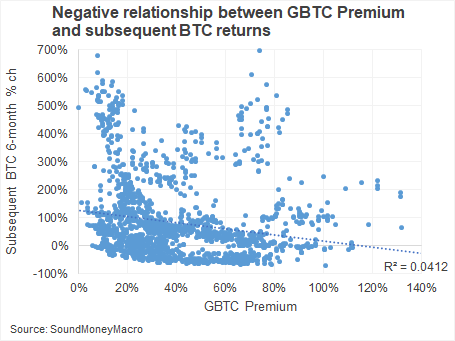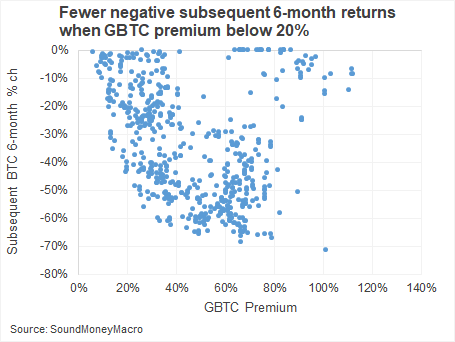The Grayscale Bitcoin Trust (GBTC) is a favoured avenue for institutional investors to gain access to bitcoin due to the ease of execution via traditional investment accounts. In this article I highlight a few of the advantages and disadvantages of the trust. The premium between the GBTC price and the actual undervaluing value of the trust highlights the price investors are willing to pay to for custody, insurance and storage services. It also makes for interesting investment analysis. The premium is currently trading at historically low levels, which provides another positive indicator for bitcoin, at least suggesting that downside risks are contained.
Advantages: Traditional financial market access
Usually investment houses clarify security, custody, insurance and their desired execution platform upfront. They build relationships with service providers, review periodically and execute on numerous instruments/securities they deem appropriate for their portfolio. They don’t concern themselves with reassessing these administrative details during each new investment. If they want to buy Apple shares, for example, they merely execute through their chosen vendor.
Bitcoin breaks the mould, which is a challenge for traditional financial institutions. Bitcoin is an alternative financial system, which isn’t plugged into all the traditional investment infrastructure yet. Seamless execution through all platforms isn’t available at this stage. There are numerous different bitcoin exchanges through which investors could execute. But institutional investors don’t necessarily want to build relationships with each new exchange. Self-custody, storage and security of bitcoin are also technically challenging. More concerning for traditional financial institutions is that the do-it-yourself approach doesn’t always align with existing investment processes. Process is VERY important for institutional investors!
Corporates like MicroStrategy, which has bought a significant amount of bitcoin for its corporate treasury, probably broke the traditional mould. I’m pretty sure they put together a framework of self-custody in conjunction with institutional partners to ensure they’ve got the highest layers of security, insurance and are implementing industry best practice with cold storage and multi-signature wallets. But from my understanding of MicroStrategy, they are an innovative business and Michael Saylor holds a lot of power on the board. Its less likely that an institutional investment house making a 1% to 5% allocation will take this leap. The knowledge and process are surmountable hurdles, but investment houses want their portfolios seamlessly visible on a single investment platform for monitoring, risk management and return attribution.
Hence the appeal of Grayscale. Investors can access GBTC through their brokerage account where GBTC can sit alongside Apple shares. It has built-in security and storage features so there’s no need for self-custody. Plus, Grayscale has audited financials.
Disadvantages: exposure, not ownership
There are downsides to the GBTC approach. GBTC ownership isn’t bitcoin ownership, its bitcoin exposure. Owners cannot make use of the bitcoin network and the advantages of the digital decentralised payment network. For example, GBTC holders cannot pay a supplier on the other side of the world through an easy bitcoin transfer. As another example, GBTC ownership confines trading activity to standard trading hours, whereas bitcoin trades 24 hours a day 7 days a week. GBTC also doesn’t allow redemptions for bitcoin. In fact, redemptions aren’t allowed for USD either. Holders must trade GBTC in the Over the Counter (OTC) markets to other participants if they want to exit a position. Additionally, Grayscale charges an annual 2% fee for this service. These disadvantages are notable, particularly for individuals who want to learn about bitcoin, use its technology and liberate their finances from our centralised and unsound financial system.
But institutional investors will probably underweight the importance of using bitcoin. It depends on their business model, approach and goals, but they’re less likely to adopt the technology into the payments technology at this stage. Exposure to the technology and asset classes is, however, very exciting. You don’t have to use a tech in your business, to invest into it.
Investors pay a Premium for access
Grayscale conducts periodic private placements where they add new bitcoin into the trust and receive new funds from clients. Clients are subject to a 1-year holding period after participating in the private placement, according to rule 144 of the securities act. There’s no active management of the fund outside of placements. Investors who don’t meet the $50K private placement threshold, or want to gain exposure outside of the placement, need to purchase on the open market. Secondary market GBTC demand can create a mismatch between the market capitalisation of the trust and the value of the bitcoin holdings in the trust. I.E. Investors are willing to pay a premium to gain exposure to bitcoin. To confirm, Grayscale allows the premium/discount to emerge in the free market. A discount is rare, but it has happened.
Analytical Insight: Buy bitcoin when premium is low
Currently the premium is 15% and historically it has averaged 38%. There is a negative relationship between the premium and subsequent BTC-USD 6-month returns. Not perfect of course, but another indicator to keep an eye on over the coming quarters. A couple of insights from the data, which is presented in the table below:
- A low GBTC premium tends to be a good time to buy bitcoin
- Downside protection: The bottom quartile of subsequent 6-month returns were +24% on average when the premium was below 20%, and +6% when the premium was below 30%.
- Upside potential: The top quartile of subsequent 6-month returns were 191% on average when the premium was below 20% and 158% when the premium was below 30%.
- A higher GBTC premium tends be a poor time to buy bitcoin
- Downside protection worse: the bottom quartile of subsequent 6-month returns were -27% on average when the premium was above 50%.
- The bitcoin price can still run much higher when the GBTC premium is elevated. So elevated premiums are a point of caution rather than an outright sell signal.
Here’s a visual representation of the premium vs. subsequent 6-month BTC-USD returns. Not a perfect relationship but the negative correlation is noticeable.
The potential limitation on downside price movements is evident in the next chart where I look at negative BTC-USD returns alone. Large negative BTC-USD observations are clustered in the 30%-100% range for the premium.
The biggest take home from this premium data is the limited downside potential when premiums are contained, as they are today. A contained premium is an indication of a reasonably well-priced bitcoin market, which creates attractive entry points for new entrants, accumulators and speculators.




One thought on “Grayscale, Institutional BTC access and premium”